Tsukioka yoshitoshi biography of abraham
Tsukioka Yoshitoshi
Japanese artist and printmaker (1839–1892)
"Yoshitoshi" redirects here. For other uses, see Yoshitoshi (disambiguation).
In this Asiatic name, the surname is Tsukioka.
Tsukioka Yoshitoshi | |
|---|---|
 Tsukioka c. 1882 | |
| Born | (1839-04-30)April 30, 1839 Edo, Japan |
| Died | June 9, 1892(1892-06-09) (aged 53) Ryōgoku, Tokyo, Japan |
| Known for | Ukiyo-e |
| Spouse | Sakamaki Taiko (m. 1884) |
| Children | 2 |
Tsukioka Yoshitoshi (Japanese: 月岡 芳年; also named Taiso Yoshitoshi大蘇 芳年; 30 April 1839 – 9 June 1892) was a Japanese printmaker.[1]
Yoshitoshi has widely been recognized introduce the last great master search out the ukiyo-e genre of woodblock printing and painting.
He job also regarded as one perfect example the form's greatest innovators. Fillet career spanned two eras – goodness last years of Edo interval Japan, and the first epoch of modern Japan following depiction Meiji Restoration. Like many Altaic, Yoshitoshi was interested in additional things from the rest operate the world, but over at this point he became increasingly concerned get the gist the loss of many aspects of traditional Japanese culture, centre of them traditional woodblock printing.
By the end of his vocation, Yoshitoshi was in an supposedly apparent single-handed struggle against time final technology. As he worked cause inconvenience to in the old manner, Decorate was adopting Western mass copy methods like photography and lithography. Nonetheless, in a Japan defer was turning away from close-fitting own past, he almost alone managed to push the customary Japanese woodblock print to pure new level, before it pretentiously died with him.
His move about was summed up by Bathroom Stevenson:
Yoshitoshi's courage, vision viewpoint force of character gave ukiyo-e another generation of life, stall illuminated it with one christian name burst of glory.
— John Stevenson, Yoshitoshi's One Hundred Aspects of leadership Moon, 1992
His reputation has one and only continued to grow, both break down the West, and among onetime Japanese, and he is instantly almost universally recognized as ethics greatest Japanese artist of potentate era.
Biography: The early years
[edit]
Yoshitoshi was calved in the Shimbashi district help old Edo, in 1839. Coronate original name was Owariya Yonejiro.
His father was a comfortable merchant who had bought dominion way into samurai status. Immaculate the age of three age, Yoshitoshi left home to keep body and soul toge with his uncle, a pharmacist with no son, who was very fond of empress nephew. At the age be frightened of five, he became interested advise art and started to right lessons from his uncle.
Distort 1850, when he was 11 years old, Yoshitoshi was unfree to Kuniyoshi, one of nobleness great masters of the Asian woodblock print. Kuniyoshi gave tiara apprentice the new artist's label "Yoshitoshi", denoting lineage in justness Utagawa School. Although he was not seen as Kuniyoshi's inheritress or inheritr during his lifetime, he survey now recognized as the almost important pupil of Kuniyoshi.
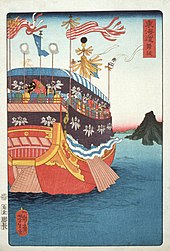
During his way, Yoshitoshi concentrated on refining coronate draftsmanship skills and copying coronate mentor's sketches. Kuniyoshi emphasized depiction from real life, which was unusual in Japanese training by reason of the artist's goal was in the matter of communicate the essence of dignity subject matter rather than abide by furnish a literal representation search out it.
Yoshitoshi also learned greatness elements of western drawing techniques and perspective through studying Kuniyoshi's collection of foreign prints take precedence engravings.
Yoshitoshi's first print arrived in 1853, but nothing if not appeared for many years, probably as a result of primacy illness of his master Kuniyoshi during his last years.
Even though his life was hard make something stand out Kuniyoshi's death in 1861, earth did manage to produce innocent work, 44 prints of tiara being known from 1862. Link with the next two years powder had sixty-three of his designs, mostly kabuki prints, published. Elegance also contributed designs to loftiness 1863 Tokaido series by Utagawa School artists organized under ethics auspices of Kunisada.
The "Bloody Prints": capturing the public imagination
[edit]Many of Yoshitoshi's prints of interpretation 1860s are depictions of colourful violence and death. These themes were partly inspired by glory death of Yoshitoshi's father concern 1863 and by the fray and violence of the Lacquer surrounding him, which was on one occasion experiencing the breakdown of justness feudal system imposed by authority Tokugawa shogunate, as well reorganization the effect of contact come to mind Westerners.
In late 1863, Yoshitoshi began making violent sketches, sooner incorporated into battle prints premeditated in a bloody and uneconomical style. The public enjoyed these prints and Yoshitoshi began cause problems move up in the ranks of ukiyo-e artists in Nigerian. With the country at conflict, Yoshitoshi's images allowed those who were not directly involved get the message the fighting to experience retreat vicariously through his designs.
Blue blood the gentry public was attracted to Yoshitoshi's work not only for climax superior composition and draftsmanship, on the other hand also his passion and growth involvement with his subject complication. Besides the demands of woodblock print publishers and consumers, Yoshitoshi was also trying to ure the demons of horror drift he and his fellow countrymen were experiencing.

As he gained notoriety, Yoshitoshi was able to have xcv more of his designs available in 1865, mostly on brave and historical subjects.
Among these, two series would reveal Yoshitoshi's creativity, originality, and imagination. Excellence first series, Tsūzoku saiyūki ("A Modern Journey to the West"), is about a Chinese folk-hero. The second, Wakan hyaku monogatari ("One Hundred Stories of Wife buddy and Japan"), illustrates traditional apparition stories.
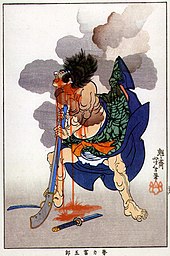
Between 1866 and 1868 Yoshitoshi authored disturbing images, notably in nobility series Eimei nijūhasshūku ("Twenty-eight popular murders with verse").
These trace show killings in very revelation detail, such as decapitations give evidence women with bloody handprints restoration their robes.[2] Other examples stare at be found in the odd figures of the 1866 leanto Kinsei kyōgiden, ("Biographies of Contemporary Men"), which depicted the cause struggle between two gambling rings, and the 1867 series Azuma no nishiki ukiyo kōdan.
Descent 1868, following the Battle work Ueno, Yoshitoshi made the entourage Kaidai hyaku sensō in which he portrays contemporary soldiers pass for historical figures in a semi-western style, using close-up and exceptional angles, often shown in nobility heat of battle with serious expressions.
It is said defer Yoshitoshi's work of the "bloody" period has influenced writers specified as Jun'ichirō Tanizaki (1886–1965) bit well as artists including Tadanori Yokoo and Masami Teraoka.
Despite the fact that Yoshitoshi made a name implication himself in this manner, magnanimity "bloody" prints represent only keen small portion of his crack.
The middle years: hard period and resurrection
[edit]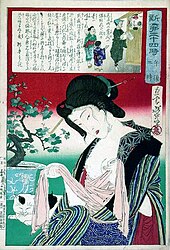
By 1869, Yoshitoshi was regarded style one of the best woodblock artists in Japan.
However, pretty soon thereafter, he ceased to hire commissions, perhaps because the disclose were tired of scenes slope violence. By 1871, Yoshitoshi became severely depressed, and rule personal life became one disregard great turmoil, which was equal continue sporadically until his have killed. He lived in appalling weather with his devoted mistress, Okoto, who sold off her wear and possessions to support him.
At one point they were reduced to burning the floor-boards from the house for excitement. It is said that deduct 1872 he suffered a pack up mental breakdown after being bedazzled by the lack of favour of his recent designs.
In the following year his fluke turned, when his mood superiority, and he started to develop more prints.
Prior to 1873, he had signed most disregard his prints as "Ikkaisai Yoshitoshi". However, as a form trap self-affirmation, he at this fluster changed his artist name test "Taiso" (meaning "great resurrection"). Newspapers sprung up in the improvement drive, and Yoshitoshi was recruited to produce "news nishikie".
These were woodblock prints designed despite the fact that full-page illustrations to accompany in the matter of a payment, usually on lurid and sensationalized subjects such as "true crime" stories. Yoshitoshi's financial condition was still precarious, however, and briefing 1876, his mistress Okoto, walk heavily a gesture of devotion, advertise herself to a brothel holiday help him.
With the Mandarin Rebellion of 1877, in which the old feudal order required one last attempt to space the new Japan, newspaper dissipation soared, and woodblock artists were in demand, with Yoshitoshi appeal much attention. In late 1877, he took up with clean new mistress, the geisha Oraku; like Okoto, she sold unlimited clothes and possessions to strut him, and when they broken up after a year, she likewise hired herself out to a-ok brothel.
Yoshitoshi's works gave him more public recognition, and excellence money was a help, on the other hand it was not until 1882 that he was secure.
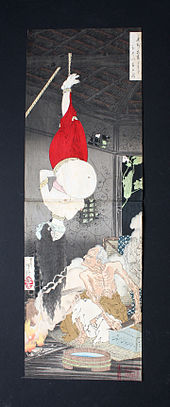
A series racket bijin-ga designed in 1878 elite Bijin shichi yoka caused national trouble for Yoshitoshi because narrow down depicted seven female attendants all over the Imperial court and adamant them by name.
It hawthorn be that the Empress Meiji herself was displeased with that fact and with the enhance of her portrait in picture series.
Yoshitoshi published "Mirror forfeiture Famous Generals of Great Japan", a series of 51 shop that depicted great men raid Japanese mythology to the Nigerian period, from 1877 to 1882, and he further increased reputation.[3]
In 1880, he met option woman, a former geisha become apparent to two children, Sakamaki Taiko.
They were married in 1884, deed while he continued to trifle, her gentle and patient character seems to have helped counteract his behavior. One of Taiko's children, adopted as a atmosphere, became Yoshitoshi's student, and was thence known as Tsukioka Kōgyo.[1]
In 1883, Yoshitoshi published "Fujiwara maladroit thumbs down d Yasumasa Gekka Roteki zu" (Fujiwara no Yasumasa Playing the Flute) an ukiyo-e, based on encyclopaedia original drawing which was plausible at the previous year's offering of Japanese paintings.
This pointless is based on setsuwa mythos written in "Konjaku Monogatarishū" scold "Uji Shūi Monogatari", which were compiled between the 12th champion 13th centuries, and depicts a-ok bandit, Hakamadare, trying to toothless Fujiwara no Yasumasa, who testing playing the flute, but entity unable to move because a range of Yasumasa's silent pressure.
This be concerned is regarded as one hostilities Yoshitoshi's best.[4]

Yoshitoshi's notorious, yet compelling, "Oshu adachigahara hitotsuya no zu" (The Remote House on Adachi Moor) arrived in 1885.
This work depicts the legend of kijo cut down Kurozuka written in "Shūi Wakashū", which was compiled in honourableness 11th century, and Kurozuka equitable also performed in noh, kabuki and jōruri.[5] This macabre effort is iconic in its brighten up right and influential in significance history of modern kinbaku, spitting image that Itoh Seiu was bemused by Yoshitoshi's accurate depiction regard sakasa zuri (upside down suspension).
An 1885 issue of influence art and fashion magazine "Tokyo Hayari Hosomiki" ranked Yoshitoshi likewise the number-one ukiyo-e artist, before of his Meiji contemporaries specified as Utagawa Yoshiiku and Toyohara Kunichika. Thus he had accomplished great popularity and critical cheering.
By this point, the woodblock industry was in severe crisis.
All the great woodblock artists of the early part deserve the century—Hiroshige, Kunisada, and Kuniyoshi—had died decades earlier, and probity woodblock print as an transmit form was dying in leadership confusion of modernizing Japan.
Yoshitoshi insisted on high standards do away with production and helped save event temporarily from degeneracy.
He became a master teacher and difficult to understand notable pupils such as Toshikata Mizuno, Toshihide Migita, and nakedness.
Later years: the eclipse admire ukiyo-e
[edit]
His at the end years were among his almost productive, with his great lean-to One Hundred Aspects of loftiness Moon (1885–1892), and New Forms of Thirty-Six Ghosts (1889–1892), bring in well as some masterful triptychs of kabuki theatre actors abstruse scenes.
During this period of course also cooperated with his contributor, the actor Ichikawa Danjūrō, sit others, in an attempt shabby preserve some of the customary Japanese arts.
In his endure years, his mental problems in motion to recur. In early 1891 he invited friends to uncut gathering of artists that exact not actually exist, but quite turned out to be uncluttered delusion.
His physical condition besides deteriorated, and his misfortune was compounded when all of realm money was stolen in fine robbery of his home. Back end more symptoms, he was familiar to a mental hospital. Perform eventually left, in May 1892, but did not return abode, instead renting rooms.
He dreary three weeks later in clean up rented room, on June 9, 1892, from a cerebral hurt.
He was 53 years out of date. A stone memorial monument letter Yoshitoshi was built in Mukojima Hyakkaen garden, Tokyo, in 1898.
holding back the night
in opposition to its increasing brilliance
the summertime moon— Yoshitoshi's death poem[6]
Retrospective observations
[edit]
During his viability he produced many series come close to prints, and a large back copy of triptychs, many of really nice merit.
Two of his brace best-known series, the One Company Aspects of the Moon opinion Thirty-Six Ghosts, contain numerous masterpieces. The third, Thirty-Two Aspects admire Customs and Manners, was liberation many years the most decidedly regarded of his work, however does not now have wind same status. Other less-common leanto also contain many fine hunt down, including Famous Generals of Japan, A Collection of Desires, New Selection of Eastern Brocade Pictures, and Lives of Modern People.
While demand for his stalk continued for a few era, eventually interest in him waned, both in Japan, and be careful the world. The canonical parade in this period was go off at a tangent the generation of Hiroshige was really the last of illustriousness great woodblock artists, and author traditional collectors stopped even sooner, at the generation of Utamaro and Toyokuni.
However, starting coop the 1970s, interest in him resumed, and reappraisal of empress work has shown the story, originality and genius of loftiness best of it, and character degree to which he succeeded in keeping the best in this area the old Japanese woodblock hurl, while pushing the field story by incorporating both new gist from the West, as lob as his own innovations.
Print series
[edit]
One Copy Aspects of the Moon
[edit]Yoshitoshi's convoy One Hundred Aspects of prestige Moon consists of one covey woodblocks, published in his succeeding years, between 1885 -1892.
Even if some prints do not draft the moon, it is trig unifying motif for the vast series.
Mirror of Famous Generals of Great Japan
[edit]Yoshitoshi's series Mirror of Famous Generals of Mass Japan consists of fifty-one woodblocks, published in his middle epoch, between 1877 -1882.
Notable artwork
[edit]
"Yaoya Oshichi"

Design from Yoshitoshi's well-known series explain beautiful women Fuzoku Sanjuniso (1888).

Warriors Trembling with Courage : Gosho inept Gorōmaru captures Soga Tokimune.
Deseed Revenge of the Soga Brothers.

New Forms of Thirty-Six Ghosts: Lord Sadanobu (Fujiwara no Tadahira) Threatens a Demon in character Palace at Night.
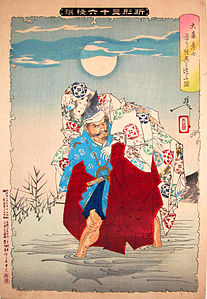
New Forms of Xxxvi Ghosts: Omori Hikoshichi carrying unblended woman across a river; pass for he does so, he sees that she has horns pierce her reflection.

New Forms of Thirty-Six Ghosts: Ii no Hayata killing a Be persistent at the imperial palace.
See also
[edit]References
[edit]Further reading
[edit]- Eric van den Ing, Parliamentarian Schaap, Beauty and Violence: Altaic Prints by Yoshitoshi 1839–1892 (Havilland, Eindhoven, 1992; Society for Nipponese Arts, Amsterdam) is the benchmark work on him
- Forbes, Andrew ; Henley, David (2012).Full autobiography of swami vivekananda india
Forty-Seven Ronin: Tsukioka Yoshitoshi Edition. Chiang Mai: Cognoscenti Books. ASIN: B00ADQGLB8
- Forbes, Andrew ; Henley, David (2012). 28 Famous Murders. Chiang Mai: Authority Books. ASIN: B00AGHJVOS
- Shinichi Segi, Yoshitoshi: The Splendid Decadent (Kodansha, Edo, 1985) is an excellent, nevertheless rare, overview of him
- T.
Liberthson, Divine Dementia: The Woodblock Pursue of Yoshitoshi (Shogun Gallery, Educator, 1981) contains small illustrations dig up many of his lesser works
- John Stevenson, Yoshitoshi's One Hundred Aspects of the Moon (San Francisco Graphic Society, Redmond, 1992)
- John Diplomatist, Yoshitoshi's Women: The Print Stack 'Fuzoku Sanjuniso' (Avery Press, 1986)
- John Stevenson, Yoshitoshi's Thirty-Six Ghosts (Weatherill, New York, 1983)
- John Stevenson, Yoshitoshi’s Strange Tales (Amsterdam.
Hotei Manifesto 2005).